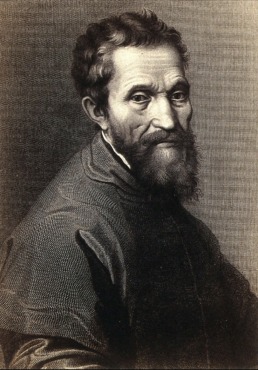These life stories may contain descriptions of childhood trauma and abuse, as well as images, voices and names of people now deceased. If you need help, you can find contact details for some relevant support services on our support page.
Acclaimed Italian renaissance artist, Michelangelo (1475-1564), was in foster care as a child.
Michelangelo di Lodovico Buonarroti Simoni was born in Arezzo, Tuscany, Italy where his father, Lodovico di Leonardo Buonarroti Simoni, was serving as the local governor. The family were in Florence in 1481 when Michelangelo’s mother, Francesca Neri di Miniato del Sera, died.
According to some sources, Michelangelo was already in foster care with a stonecutter’s family before his mother died. It was not unusual for children of his class to be with a wet nurse, and Francesca was often pregnant and often unwell. It appears the six-year-old continued to stay on in foster care after his mother’s death and worked alongside the other children in the family to cut stone from a local quarry.
When he was seven years old, Michelangelo was sent to school. Because he showed more interest in art than schoolwork, his father beat him. Eventually, Michelangelo’s father conceded defeat and had the thirteen-year-old boy apprenticed to a fresco painter, Domenico Girlandaio, Florence’s most distinguished painter, but he left after a year. Michelangelo was then mentored by Lorenzo de’Medici, who was able to secure high-level social connections for the boy.
After de’Medici died in 1492, Michelangelo returned to live briefly with his father before departing first for Venice and then Bologna. He returned to Florence before moving to Rome, where he looked for commission work.
In Rome, where he stayed for five years the first time, Michelangelo learned to play politics and to establish his reputation. The French ambassador commissioned Michelangelo to carve a sculpture of Mary grieving the death of Jesus; the work is now in St Peter’s Basilica.
After a sojourn back in Florence, Michelangelo was invited back to Rome to build the Pope’s tomb, a project he worked on for many years.
He also painted the ceiling of the Sistine Chapel which took from 1508 to 1512 to complete.
Michelangelo went on to become known as one of the most influential Western artists. Many regard him as the greatest artist of his time, and some the most significant of all time.
References:
Gilbert, Creighton. “Michelangelo: Italian artist”. Britannica, 1998. https://www.britannica.com/biography/Michelangelo
McNeese, Tim. Michelangelo: Painter, Sculptor, and Architect. Infobase Publishing, 2005.
Muntz, Eugene. Michelangelo. Parkstone International, 2010.
Nickerson, Anglea. A Journey Into Michelangelo’s Rome. Roaring Forties Press, 2008.
Wohl, Hellmut. The Life of Michelangelo. Penn State Press, 1999.
Image available here.
